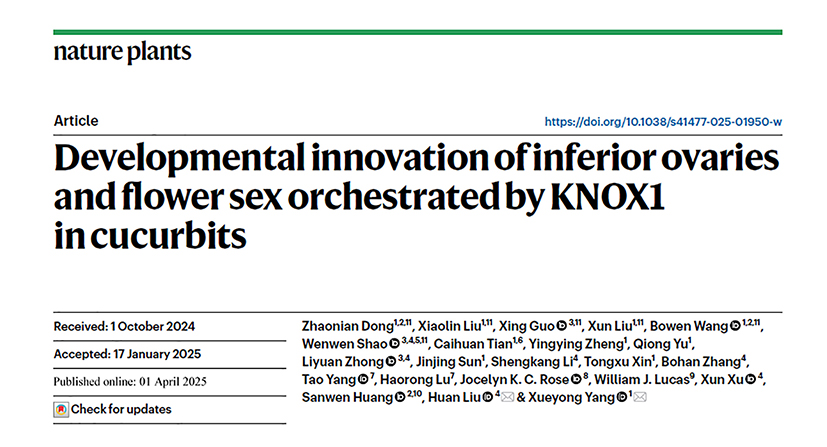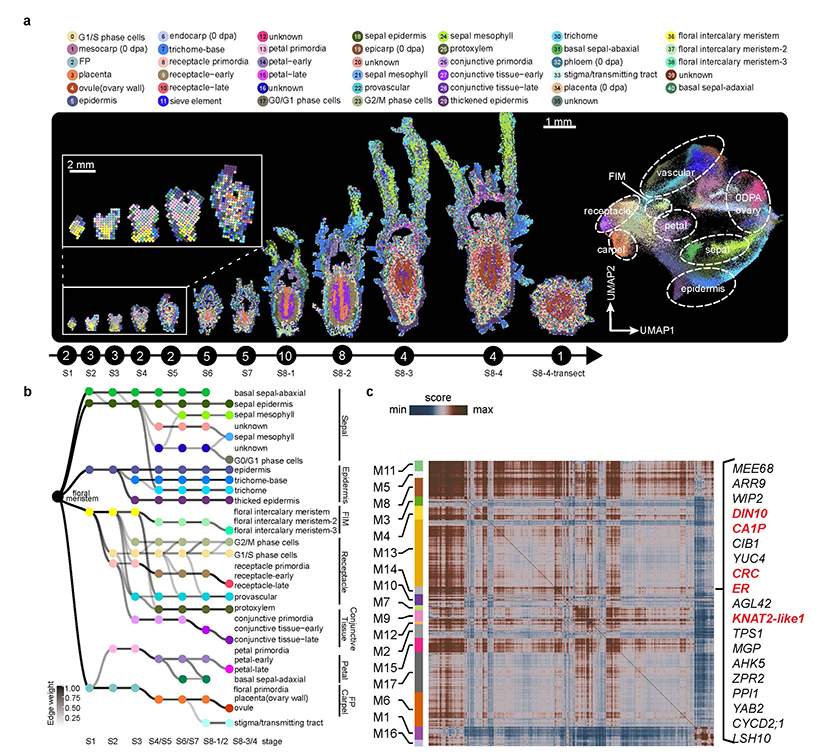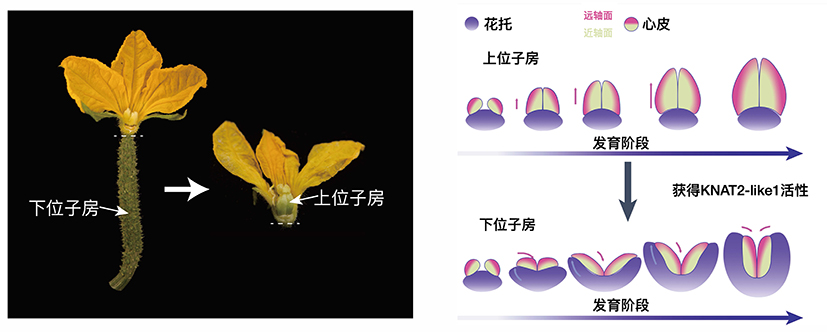In angiosperms, ovaries are categorized as either superior or inferior based on their spatial position relative to other floral organs. An inferior ovary is located below the point of attachment of the sepals, petals, and stamens, whereas a superior ovary is situated above these floral structures. Inferior ovaries have independently originated multiple times during the evolution of angiosperms and are now widely distributed across several major clades. Their adaptive advantages include enhanced protection of the gynoecium, reduced risk of environmental damage, and more efficient energy allocation within the ovary.

Although anatomical and comparative developmental studies have proposed several hypotheses regarding the evolution of inferior ovaries—such as differential fusion of floral organs or the overgrowth of the floral receptacle around the carpels—genetic explanations remain limited. In cucurbit crops such as cucumber, melon, and watermelon, the fruits are pepos derived from inferior ovaries. Many accessory fruits, including apples and pears, also originate from inferior ovaries. Despite the biological and economic importance of these fruits, the genetic and developmental mechanisms underlying the formation of inferior ovaries remain poorly understood. Elucidating the genetic and molecular basis of inferior ovary formation not only provides insights into the evolutionary history of this key trait but also offers valuable implications for fruit development and breeding strategies.
Recently, a research team led by Prof. Xueyong Yang from the Institute of Vegetables and Flowers, Chinese Academy of Agricultural Sciences (CAAS), in collaboration with BGI Research and other institutions, published a study in Nature Plants titled “Developmental innovation of inferior ovaries and flower sex orchestrated by KNOX1 in cucurbits.” Using Stereo-seq, a spatial transcriptomics technology developed by BGI, the researchers constructed the first spatiotemporal transcriptomic atlas of floral development in cucumbers and reconstructed its cellular lineage. Their findings revealed that the activity of the floral intercalary meristem (FIM) drives accelerated growth of the receptacle in cucumber, which in turn leads to the development of female flowers and the formation of inferior ovaries. The study proposes that an enlarged receptacle represents a key evolutionary innovation underlying the origin of both unisexual flowers and inferior ovaries in the Cucurbitaceae family.

Figure 1. Spatial transcriptomic atlas of cucumber female flower buds
Through phylogenetic analysis, the research team found that bisexual flowers and superior ovaries represent ancestral traits in angiosperms, whereas unisexual flowers and inferior ovaries are evolutionary innovations that have arisen independently multiple times. Interestingly, in Cucurbitaceae, the traits of unisexual flowers and inferior ovaries co-occur, suggesting that they may have originated from a shared evolutionary event. Histological analysis revealed that, during the early developmental stages of cucumber female flowers, the floral primordium becomes concave, accompanied by the rapid growth of the peripheral tissue, which pushes the sepals, petals, and stamens upward to the top of the flower. Meanwhile, the developing carpels remain enclosed within the receptacle, ultimately giving rise to the inferior ovary. It is hypothesized that the peripheral tissue responsible for the formation of the inferior ovary may correspond to the enlarged floral receptacle.
To gain deeper insights into the gene expression network underlying inferior ovary development in cucumber, the research team performed spatial transcriptomic analysis on 52 high-quality samples collected from floral buds at eight developmental stages (S1–S8) and ovary tissues on the day of flowering. A total of 41 cell clusters spanning different developmental stages were successfully identified and annotated, laying a solid foundation for elucidating the developmental mechanisms of inferior ovary formation in cucumber (Figure 1a). In plant development, the progressive differentiation of cell fate determines the final structure of organs. By adapting trajectory inference methods originally developed for mammalian embryogenesis, the researchers established a cucumber-specific Trajectory of Floral Organogenesis (TOFO) framework, which enabled precise reconstruction of the dynamic process of cell fate transitions. Notably, the floral intercalary meristem (FIM) was shown to give rise to both the receptacle and the connecting tissue between the receptacle and carpels. Integrating genome-wide association analysis, the study further revealed that the major flesh tissue of cucumber fruit does not originate from carpels, but is instead derived from the receptacle. This finding provides a new perspective and breeding strategy for fruit quality improvement in cucumber and other cucurbit crops (Figure 1b).

Figure 2. Diagram of ovary formation in KNAT2-like1 mutant (superior ovary) and WT (inferior ovary) cucumber
Further evidence confirmed that the rapid growth of the receptacle, which exhibits meristem-like activity, is critical for the formation of the inferior ovary. Through TOFO trajectory analysis, the researchers identified a key regulatory factor involved in receptacle proliferation—KNAT2-like1. This transcription factor functions not only during the early stages of receptacle development but also plays a vital role in subsequent cell proliferation. Moreover, spatial co-expression module analysis revealed that KNAT2-like1, CRC, and ER form a tightly connected regulatory network that promotes cell proliferation and drives the rapid growth of the receptacle (Figure 1c). In cucumber, knockout of KNAT2-like1 leads to the transformation of numerous female flowers: receptacle development is arrested, and bisexual flowers with tomato-like superior ovaries are formed. This finding indicates that KNAT2-like1 is a key regulatory factor in receptacle development (Figure 2). Further genetic functional validation supports the cooperative role of the KNAT2-like1–CRC–ER regulatory module in both inferior ovary formation and floral organ identity determination.
In summary, this study is the first to elucidate the functional roles of key genes—including a novel KNOX1 transcription factor—in receptacle development. The results demonstrate that these genes regulate meristematic activity, playing a central role in both inferior ovary formation and floral organ patterning. The authors further propose that inferior ovary development and unisexual flower formation may have originated from a common evolutionary event in Cucurbitaceae. This discovery not only deepens our understanding of the evolution of reproductive structures in angiosperms but also provides new directions for molecular breeding and crop improvement.
Zhaonian Dong (joint Ph.D. student at the Institute of Vegetables and Flowers, Chinese Academy of Agricultural Sciences, and the Agricultural Genomics Institute at Shenzhen), Xiaolin Liu (postdoctoral researcher), Xun Liu (master’s student), and Bowen Wang (Ph.D. student) from the Institute of Vegetables and Flowers, as well as Xing Guo (associate researcher) and Wenwen Shao (Ph.D. student) from BGI Research, are co-first authors of the paper. Prof. Xueyong Yang (Institute of Vegetables and Flowers, CAAS) and Dr. Huan Liu (BGI Research) are co-corresponding authors. The Institute of Vegetables and Flowers, CAAS, is listed as both the first author and corresponding author affiliation. This work was supported by the National Key R&D Program of China, the Excellent Young Scientists Fund and Young Scientists Fund of the National Natural Science Foundation of China, and the Science and Technology Innovation Program of the Chinese Academy of Agricultural Sciences.
Link to this paper: https://www.nature.com/articles/s41477-025-01950-w